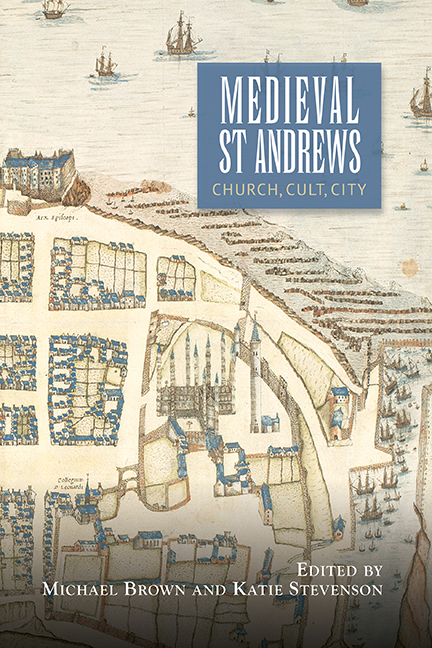Book contents
- Frontmatter
- Dedication
- Contents
- List of Illustrations, Charts and Tables
- Contributors
- Abbreviations
- 1 ‘Ancient Magnificence’: St Andrews in the Middle Ages: An Introduction
- 2 From Cinrigh Monai to Civitas Sancti Andree: A Star is Born
- 3 The Idea of St Andrews as the Second Rome Made Manifest
- 4 The Medieval Ecclesiastical Architecture of St Andrews as a Channel for the Introduction of New Ideas
- 5 When the Miracles Ceased: Shrine and Cult Management at St Andrews and Scottish Cathedrals in the Later Middle Ages
- 6 Religion, Ritual and the Rhythm of the Year in Later Medieval St Andrews
- 7 Living in the Late Medieval Town of St Andrews
- 8 The Burgh of St Andrews and its Inhabitants before the Wars of Independence
- 9 The Archaeology of Medieval St Andrews
- 10 Prelates, Citizens and Landed Folk: St Andrews as a Centre of Lordship in the Late Middle Ages
- 11 Augmenting Rentals: The Expansion of Church Property in St Andrews, c. 1400–1560
- 12 The Prehistory of the University of St Andrews
- 13 University, City and Society
- 14 The Medieval Maces of the University of St Andrews
- 15 Heresy, Inquisition and Late Medieval St Andrews
- Appendix 1 The St Andrews Foundation Account
- Appendix 2 The Augustinian' Account
- Appendix 3 The Boar' Raik
- Appendix 4 University of St Andrews Library, UYSL 110/6/4
- Index
- Miscellaneous Endmatter
8 - The Burgh of St Andrews and its Inhabitants before the Wars of Independence
Published online by Cambridge University Press: 28 April 2017
- Frontmatter
- Dedication
- Contents
- List of Illustrations, Charts and Tables
- Contributors
- Abbreviations
- 1 ‘Ancient Magnificence’: St Andrews in the Middle Ages: An Introduction
- 2 From Cinrigh Monai to Civitas Sancti Andree: A Star is Born
- 3 The Idea of St Andrews as the Second Rome Made Manifest
- 4 The Medieval Ecclesiastical Architecture of St Andrews as a Channel for the Introduction of New Ideas
- 5 When the Miracles Ceased: Shrine and Cult Management at St Andrews and Scottish Cathedrals in the Later Middle Ages
- 6 Religion, Ritual and the Rhythm of the Year in Later Medieval St Andrews
- 7 Living in the Late Medieval Town of St Andrews
- 8 The Burgh of St Andrews and its Inhabitants before the Wars of Independence
- 9 The Archaeology of Medieval St Andrews
- 10 Prelates, Citizens and Landed Folk: St Andrews as a Centre of Lordship in the Late Middle Ages
- 11 Augmenting Rentals: The Expansion of Church Property in St Andrews, c. 1400–1560
- 12 The Prehistory of the University of St Andrews
- 13 University, City and Society
- 14 The Medieval Maces of the University of St Andrews
- 15 Heresy, Inquisition and Late Medieval St Andrews
- Appendix 1 The St Andrews Foundation Account
- Appendix 2 The Augustinian' Account
- Appendix 3 The Boar' Raik
- Appendix 4 University of St Andrews Library, UYSL 110/6/4
- Index
- Miscellaneous Endmatter
Summary
THANKS to the remarkable survival of the text of a charter of Robert, bishop of St Andrews (1127–59), our understanding of the foundation of a burgh as the kingdom's premier ecclesiastical centre, St Andrews, is better than for many much larger royal burghs. Dating to between 1140 and 1159 (and possibly to 1152), Robert's charter relates that King David I (1124–53) had provided the bishop with one of his burgesses of Berwick-upon-Tweed, Mainard the Fleming, a man whom numismatic sources reveal was a royal moneyer there. It was Mainard who ‘started to build and stock the said burgh from scratch’, a task which prompted the bishop to make him the burgh's first grieve. The burgh was founded around the same time as the Augustinian cathedral priory, which A. A. M. Duncan has argued definitively dates to 1140. St Andrews was certainly the first episcopal burgh in the kingdom, and probably the second non-royal burgh, after the abbot of Holyrood's burgh of Canongate. In the 1140s its harbour would have made a convenient stopping point between the burgeoning trading centres at Berwick and Perth; by later in the century, how-ever, many other such ports acquired burghal status under the king and his relatives, notably Inverkeithing, Kinghorn, Crail and Dundee.St Andrews' burgesses quickly acquired full parity with the king's, obtaining a charter in 1160 from King Máel Coluim (Malcolm IV, 1153–65) granting them the same rights as his own royal burgesses across the kingdom. Surviving as a contemporary single-sheet manuscript, this is the earliest surviving royal charter to a burgh in the kingdom (see figure 8.1). A persistent theme of the burgh's early history was its tendency to keep pace with royal burghs in terms of developments in governance and trade.
Settlement and commerce had certainly preceded the burgh's foundation. As the seat of the kingdom's top bishop, with the shrine of St Andrew acting as a magnet for pilgrims, the church settlement on the headland had long been a place where people came together and mixed. Archaeologists have noted the significance of Kirkhill, near the harbour, as the centre of early settlement.
- Type
- Chapter
- Information
- Medieval St AndrewsChurch, Cult, City, pp. 141 - 172Publisher: Boydell & BrewerPrint publication year: 2017

